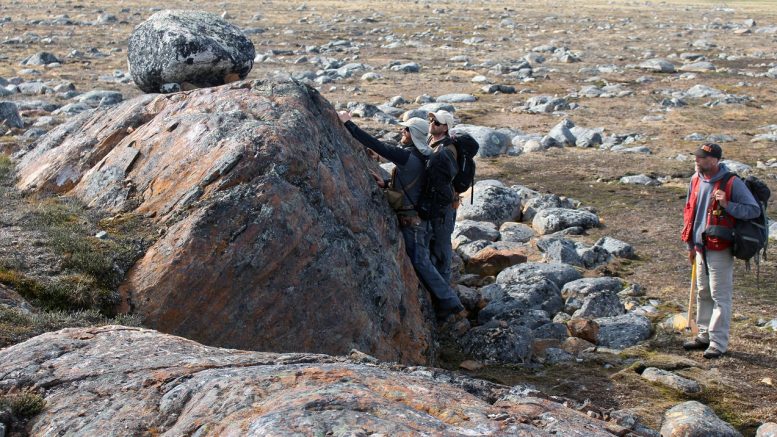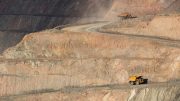VANCOUVER — The Northern Miner reached out to a number of geologists living in the Vancouver area and asked them to identify ways that a non-technical person can tell if an exploration company is carrying out high quality work at an early stage project. The following five encouraging signs are an amalgam of these discussions.
1. Transparency with precious metal assay results — Ever since gold prices began to rally last year, there has been a surge of “uncut” or uncapped assays being reported by gold explorers.
This is in contrast to the more traditional reporting of “cut” or capped assays whereby very high-grade assays — representing the fluky appearance of gold nuggets in core, also called the “nugget effect” — are arbitrarily reduced to a maximum such as 30 grams gold per tonne. (For example, a company reporting cut assays would report all three actual assays from the lab of 182 grams gold per tonne, 97 grams gold and 40 grams gold as a “cut” 30 grams gold per tonne, and then later use these cut assays when calculating any resource estimate.)
While the uncut assays are in a sense “truer”, the cut assays are a better reflection of the actual head grade that a mine operator would get while mining that particular portion of the mineralized body.
So there is nothing technically wrong with reporting uncut assays, it’s just that reporting cut assays shows a company is more conservative and realistic in its promotion. Ideally, a company reporting will report cut assays alongside any extraordinarily high uncut assay.
A second and often related promotional trick is called “rubberholing”, whereby a very narrow high-grade assay (often uncut) is mathematically “smeared” over a much larger width, making the intercept appear far more impressive than it actually is.
For example, what might be reported sensationally as a 10-metre wide, uncut gold-mineralized intercept that hints at cheaper bulk–mining potential could actually be a 30-centimetre interval of extraordinary high-grade gold, surrounded by a halo of near-barren material.
A company that is confident with its results will present sub-intervals if reporting uncut assays, and provide a full list of assay results in the press release or on its website to increase transparency.
An example of cut versus uncut assays is found in Barsele Minerals’ (TSXV: BME) latest press release.
Corebox Online Services Inc.’s drill hole interval calculator, jointly developed with newsletter writer Brent Cook from Exploration Insights, provides a means of estimating the residual grade between the highlights of a longer assay interval.
2. A strong understanding of the project’s structural geology — While deposit types vary in all kinds of qualities, such as alteration patterns, sulphide mineral presence, geochemical signatures and geophysical response, there’s one commonality: they all have some level of structural control.
An understanding of how rocks have been bent and broken at a property can give an exploration company great insight into its mineral targets. However, obtaining structural data is often a low priority compared to carrying out geochemical and geophysical surveys.
A geologist will obtain structural information from both geological mapping and orienting drill core — the latter a process whereby a core logger records the dip and azimuth of particular structural features observed down-hole. Geophysical data can also aid in structural interpretation.
Companies that have a good handle on a project’s structural geology are more likely to develop a robust geological model for targeting mineralized zones. They’ll hire a structurally-focused geological consulting firm or individual consultant for a specific study, or have one or more structural geologists on staff.
Auryn Resources (TSX: AUG) is one example of a company using structural geology to add value to a project, in this case its Committee Bay gold project in Nunavut.
3. Drill results are reported in context — There’s more to a drill hole than just a series of assays, yet some companies frequently report results without plan maps or cross sections. Understanding where a drill hole sits relative to previous drilling can be valuable for investors who are contemplating jumping in on a stock.
For example, if gold is intercepted 300 metres away from a previous drill hole, the result may be from an entirely different vein or system. An intercept 25 metres may very well be an extension of the known zone. And if gold is intercepted only 5 metres from a previous drill hole or the drilling merely repeats an historic hole, the result probably hasn’t added much value to the prospect.
In terms of how a company communicates results, it’s good to keep in mind that the exploration industry is on the brink of massive technological change, with augmented reality and robust three-dimensional software redefining how a company explores its projects and then present the results.
A company that is well-organized and confident in the potential of its project will not only place its drill results into context, but will seek out innovative ways to help investors visualize and understand the project.
For example, leading Canadian junior explorers Integra Gold (TSXV: ICG) and NexGen Energy (TSX:NXE) commonly include detailed drill results combined with cross sections and plan maps.
4. Detailed geology maps — Any seasoned geologist knows that bedrock exposed at surface is equivalent in value to thousands of drill holes spread horizontally across a project area. If interpreted properly, surface data can give a company a considerable head start on where to look for a potential deposit.
A geologist will begin creating a geological map by drawing the shape of any observed outcrops, and colour the units according to rock type. This is called a “fact” map. Once the fact map is complete, a geologist will use his or her knowledge of structures or stratigraphy, or other available imagery datasets, to complete larger-scale interpretations of the area.
Despite their intrinsic value, fact maps are disappearing from company’s websites and technical reports, and are being replaced with generalized and interpretative geology maps that lack pertinent data. As a result, third-parties are unable to assess whether a company’s stated geological model is based on reality or drifts too far into conjecture.
A company that has a strong foundation for planning drill holes will present the public with detailed, up-to-date geology maps, and revise the maps as necessary whenever new information from drilling or geophysical surveying becomes available.
Arizona Mining (TSX: AZ) is a great example of a junior company that presents investors with a large amount of technical data for its flagship Hermosa zinc-lead-silver project in Arizona in a compelling fashion without being overwhelming.

Arizona Mining’s geology fact map (darker shades) against interpretative geology (lighter shades) for its Hermosa zinc-lead-silver project in Arizona. From the image, it’s clear that the interpretative geological boundaries presented are tightly constrained with surface data.
5. Room for creativity and luck — While a company may have a deep understanding of the geology of its project area, it’s impossible to know everything. Sometimes, earnest and methodical scientific inquiry needs to be combined with creativity, mistakes or plain dumb luck to make an unexpected discovery.
A company that is well-balanced will maintain strong roots in science and engineering, but be adventurous enough to go against the grain and take a few risks along the way.
The avant-garde Ivanhoe Mines (TSX: IVN) is an example of a company that combines scientific reasoning with out-of-the-box thinking to generate outstanding exploration successes, most recently with its Kamoa and Kakula copper discoveries in the Democratic Republic of the Congo.






Be the first to comment on "Commentary: Signs of a good exploration team"